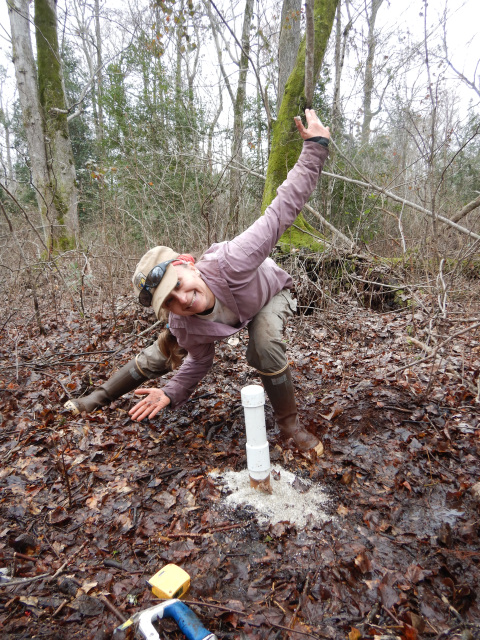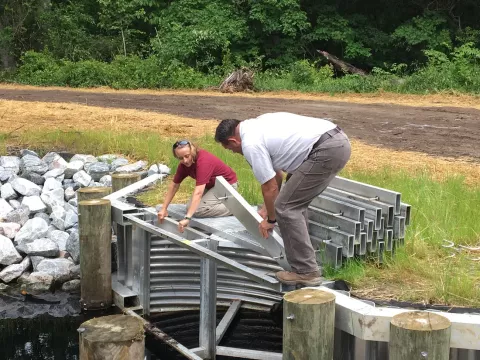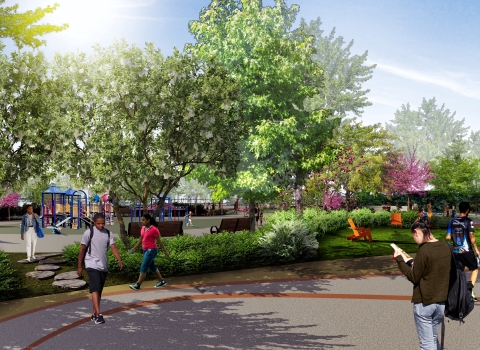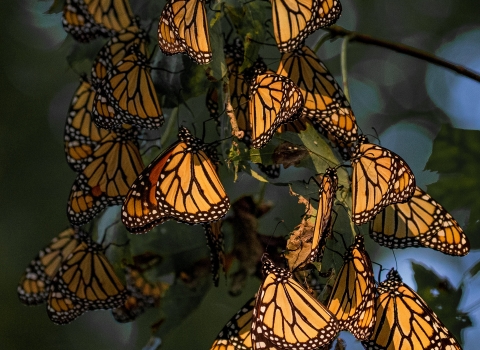Tromping through a thick, dense swamp while swatting away bugs may not appeal to everyone, but for Karen Balentine, this is a great day at work.
“I like being out in the swamp. I like going out in the field, collecting all this data, and then coming back and analyzing it,” Balentine said.
A hydrologist at Great Dismal Swamp National Wildlife Refuge in Virginia, she spends most days monitoring the swamp’s water levels. On any given day, she might use an auger to drill a groundwater well in a remote area of the swamp, troubleshoot a solar-charged data collection station, or sit at her computer analyzing data. Since starting at Great Dismal Swamp in 2014, Balentine has collected nearly eight years of data on the swamp’s hydrology, peat soil and forest health.
For the swamp, this is significant.
A simple necessity
The U.S. Fish and Wildlife Service has been working to improve understanding of the swamp’s hydrology since the refuge was established in 1974.
For hundreds of years, people dug ditches — a collective 150-miles-worth — to drain the area for logging. Though some people benefited financially, the ecosystem suffered — native species began to disappear.
Ditching and draining the swamp also dried the peat, the partially decomposed, organic material that fills the swamp. Peat, like a sponge, can absorb more water if it stays wet. Dried peat increases the likelihood of fires and flooding. In addition to holding water, peat holds a significant amount of carbon from the decaying plants it’s made from – twice as much as forests of comparable size.
Recent wildfires and flooding underscored the importance of rewetting the swamp and restoring its natural hydrology in the face of climate change climate change
Climate change includes both global warming driven by human-induced emissions of greenhouse gases and the resulting large-scale shifts in weather patterns. Though there have been previous periods of climatic change, since the mid-20th century humans have had an unprecedented impact on Earth's climate system and caused change on a global scale.
Learn more about climate change , which amplifies these threats. To counter the draining, we used Disaster Relief Appropriations Act funding, provided in the wake of Hurricane Sandy in 2013, to plug the ditches with water control structures. These small dams enable us to adjust how much water is held in or allowed to flow out.
Something temporarily or permanently constructed, built, or placed; and constructed of natural or manufactured parts including, but not limited to, a building, shed, cabin, porch, bridge, walkway, stair steps, sign, landing, platform, dock, rack, fence, telecommunication device, antennae, fish cleaning table, satellite dish/mount, or well head.
Learn more about structure by adding or removing steel stop-logs.
Measuring success
Since the installation of water control structures, water levels throughout the swamp have slowly started to rise.
We know this thanks to Balentine.
She’s installed and maintained a network of more than 100 monitoring stations throughout the 112,000-acre refuge, many equipped with solar-powered, data-collection platforms that record the swamp’s water level every 15 minutes.
“The long-term operation and maintenance of that type of equipment is a real specialized skillset. It requires attention to detail and thoroughness,” said Fred Wurster, geomorphologist and Balentine’s supervisor. “You’ve got to kind of be an electrician. You’ve got to be able to do construction. You’ve got to just know the science of what you’re doing as well.”
With nearly 50 units collecting data throughout the refuge, knowing what to do with all that information is a tremendous feat. Fortunately, with Balentine’s expertise in processing the data, we can confidently analyze and interpret it to make management decisions. In the eight years she’s been driving the project, she’s lost very little data.
“It's easy to throw these sensors out and collect a bunch of information, but if you're not doing all the quality-assurance and quality-control steps, that data is worthless,” Wurster said. “And to do it over multiple years requires a significant effort.”
Now that the refuge has cohesive data from before and after water control structures were installed, we can see the water levels slowly trending upward, just like we hoped.
This has benefits beyond Great Dismal Swamp. Restoring its natural power to hold carbon will allow the swamp to offset the annual emissions of 42,000 vehicles.
Sister swamps
Great Dismal Swamp isn’t the only site that’s benefited from Balentine’s zeal and skillset. She’s ventured to Indonesia with Service colleagues to connect with staff at Sebangau National Park — the refuge’s “sister park” — through the U.S. Department of the Interior’s International Technical Assistance Program.
Like Great Dismal Swamp, Sebangau National Park is a drained peat swamp with a history of logging and peat fires. There are hundreds of miles of ditches throughout the landscape. They also use water control structures to manage water levels.
With similar challenges involving collecting water-level data and managing peat fires, the teams benefited from sharing knowledge and experiences with each other. One of the Indonesian team’s goals was to become more proficient in statistical analysis to interpret hydrologic data, and Balentine stepped up to teach a workshop on that topic.
“It was an exchange,” Balentine explained, recounting the new ideas and techniques she learned from the Indonesian park staff. “If we have a site that’s a mile in, and we can’t carry all our fancy gear, I’m going to [try their simpler technique to build a water control structure]. They use natural logs and sticks.”
Soaking it all in
Back at Great Dismal Swamp, Balentine is known for being a team player who can jump in wherever she’s needed. Besides water-level monitoring, she helps with other refuge programs, including monitoring 12 surface elevation tables, devices that measure sediment accumulation in wetlands, and leading a forest inventory project that documented the current state of the refuge’s forest.
“It’s a baseline study, so as we make changes, such as raising water levels, [we can see] how the vegetation changes,” Balentine said.
Even on her days off, Balentine enjoys hiking through the swamp — the Washington Ditch Trail to Lake Drummond is her favorite. She’ll pass by a few of the water control structures on her way. Since it will take a while to see the impacts of raising the water in the swamp, the structures are one of the few signs of her efforts. Even so, she knows what she’s doing will improve the future.
“[If you let peat dry up because] you don't have a place that helps hold the water back, you'll have more flooding. You just have all these other consequences,” Balentine said. “It’s important to preserve these kinds of lands.”
With water at its foundation, the refuge is fortunate Balentine has kept projects flowing for so long. After nine years of research at Great Dismal Swamp, her next adventure will be with the Natural Resource Conservation Service in Virginia. As she tromps through the refuge one last time, she can rest assured she's leaving the site better and with more data than when she arrived. Though her footprints may disappear into the swamp, her impact will endure.







